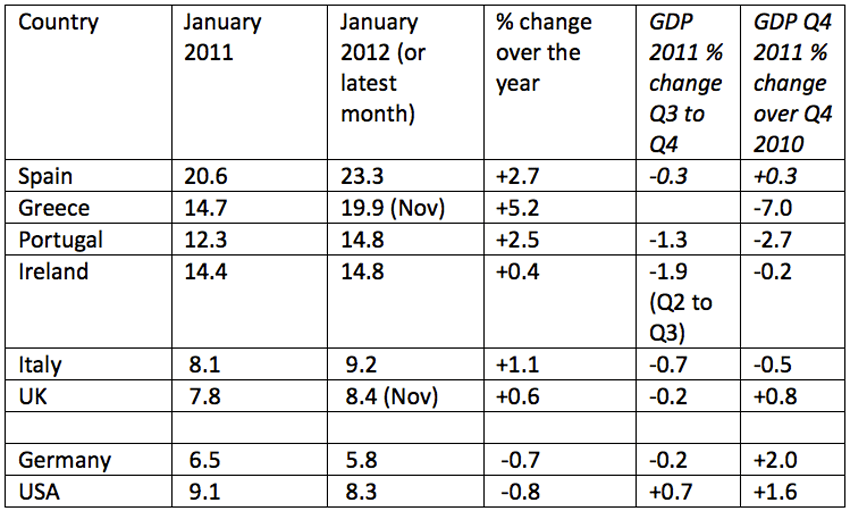Today (Friday 2nd March), 25 out of 27 EU Member States are due to give their agreement to the draft Treaty on Stability, Coordination and Governance in the Economic and Monetary Union. Its very first Article makes a bold – PRIME would say contradictory – claim:
“By this Treaty, the Contracting Parties agree, as Member States of the European Union, to strengthen the economic pillar of the Economic and Monetary Union by adopting a set of rules intended to foster budgetary discipline through a fiscal compact, to strengthen the coordination of economic policies and to improve the governance of the euro area, thereby supporting the achievement of the European Union’s objectives for sustainable growth, employment, competitiveness and social cohesion.” (Our emphasis).
Note the ‘thereby’ – a causal connection is asserted. Yet far from enhancing growth, employment and social cohesion, the Treaty seems destined to promote the precise opposite – making the use of the classical treaty term “Contracting Parties” more than usually apt in double-entendrish kind of way.
For once again, the economic Boa-Maastrichtor (quantitative squeezing) at the heart of the treaty is the fixation on the perceived need for balanced budgets, as if this can deliver growth and employment, even when it requires the toughest austerity.
Under Article 3,
“1. The Contracting Parties shall apply the following rules, in addition and without prejudice to the obligations derived from European Union law:
a) The budgetary position of the general government shall be balanced or in surplus.
b) The rule under point a) shall be deemed to be respected if the annual structural balance of the general government is at its country-specific medium-term objective as defined in the revised Stability and Growth Pact with a lower limit of a structural deficit of 0.5 % of the gross domestic product at market prices….”
The Contracting Parties are then required to “ensure rapid convergence towards their respective medium-term objective”, with the time frame for convergence being proposed by the European Commission. The revised Stability and Growth Pact sets out in lugubriously algebraic detail the scales of respective obligations on states, depending on whether they are at their Medium Term Objective (MTO) or not – and for those further away, the path of budget reductions is to be faster.
The trouble is, the austerity measures are killing the patient – or at least, damaging an ever-growing percentage of its population. Today (Thursday), Eurostat published the latest EU-wide unemployment figures, which are somewhat worse for the Eurozone countries as a whole than for the EU as a whole. And the EU is worse than, for example, the USA or Japan.
And it is no surprise that the States with the highest unemployment are generally those who are being required to undertake more stringent austerity programmes.
Seasonally adjusted unemployment rates % and GDP changes for selected countries (source Eurostat)
In the last few days, Spain’s conservative prime minister, Manuel Rajoy, has been urging other Eurozone governments and the European Commission to ease back on the speed of deficit reduction the country has had to sign up to, given that in the real world, the country’s deficit has proved to be higher than earlier anticipated. To stick to the hitherto agreed targets would mean more reductions… and still higher unemployment.Other smaller states (especially the central/eastern Europe group) whose GDP suffered greatly but has started to grow again still have very high unemployment rates – e.g. Lithuania (down from 16.3 to 14.3%), Estonia (down 1.9% to 11.7), Bulgaria (up 0.3% to 11.5%) and Slovakia (down 0.3% to 13.3%). Poland, which had done better during the crisis, has seen its rate go up over the year by 0.7% to 10.1%.
With unemployment in Spain at 23%, and youth unemployment (under 25s) at 49.9% – up 5.9% from January 2011; with unemployment in Greece touching on 20%, and youth unemployment at 48% in November; with youth unemployment up in Portugal 8.6% over the year to 35.1%; in Italy 31.1% and in Ireland standing at 29.6%…..all this is not quite what we understand by “social cohesion”.
“Sustainable growth, employment, competitiveness, social cohesion”. That’s what the new Treaty promises to support. Instead, it will reinforce current policies which squeeze the life out of the most vulnerable economies of Europe, and reinforce social divisions and inequality.
Meanwhile, under the ECB’s latest ‘quantitative easing that dares not speak its name’ the banks (who caused the crisis) can borrow at 1% from the European Central Bank, and lend on to governments and individuals at much greater rates.







